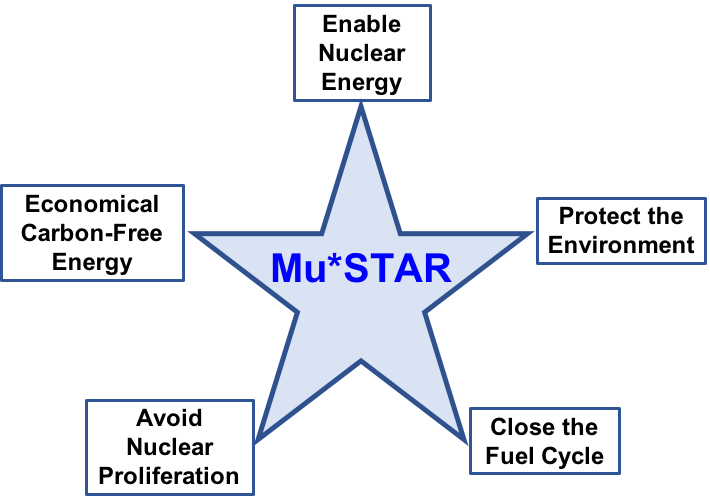| Top | Many Advantages | How It Works | Technology: System | Technology: Accelerator | Technology: Reactor |
Mu*STAR provides a sensible and profitable approach to nuclear waste.

|
Mu*STAR does this by consuming spent nuclear fuel while economically generating carbon-free nuclear energy. Mu*STAR enables all nuclear technologies, because a sensible approach to handling nuclear waste is now required by the public, and by law in many jurisdictions. Mu*STAR is an accelerator-driven subcritical reactor (ADSR). |
Superconducting-accelerator-driven: the superconducting particle accelerator provides a proton beam used to create an enormous neutron flux to drive the subcritial reactor. Superconducting accelerators are a recent development that makes this approach both feasible and economical.
Subcritical: the nuclear chain reaction is not self-sustaining, so it requires an external neutron flux; removing that flux makes the reactor shut down within a second. This also provides significantly increased safety margins and other cost and operational benefits.
Reactor: a nuclear chain reaction is used to generate heat by utilizing the enormous energy remaining in spent nuclear fuel, extracting much more energy without increasing the volume of waste. During this process the long-lived radio-toxic components are transmuted into much shorter-lived isotopes.
This is a radical new approach to nuclear energy – it is not your grandfather's reactor:
- The accelerator permits subcritical operation:
- Gives larger safety margins, which reduce regulatory, construction, and operational costs.
- Breaks the restrictive link between maintaining criticality and fuel selection.
- Permits the use of low-reactivity fuels like spent nuclear fuel and both natural uranium and thorium (no uranium enrichment required).
- Permits the use of high-reactivity but difficult to control fuels like plutonium (no MOX needed).
- The accelerator never drives the reactor to criticality:
- Criticality depends only on the geometry, moderator, and fuel.
- The reactor is always subcritical, incapable of self-sustained operation. (NRC comment: "Not a nuclear reactor by our definition.")
- The accelerator beam creates spallation neutrons, each of which initiates a fission chain that dies out in the subcritical core.
- The system will be reliable enough to provide base-load electrical power:
- This complements intermittent renewable sources, such as wind and solar, in the absence of economical energy storage at scale.
- The liquid fuel has no cladding to fracture due to thermal stresses from accelerator outages (a problem in other ADSR designs with fuel rods).
- The accelerator will be designed with conservative parameters and redundancy to achieve high availability, as will the rest of the system.
- The plant has a thermal energy storage unit sized to bridge the vast majority of interruptions.
- Mu*STAR can reduce the waste from other reactors to the radioactivity of natural uranium in a few hundred years (not the 100,000 years of the original waste).
- The accelerator provides the neutrons required to do this, handling the low reactivity of the waste.
- All reactors have waste, including Mu*STAR. But the Mu*STAR design is one of the few designs that can reduce the radio-toxic lifetime of its waste to such low values, economically.
Mu*STAR is thus a system that:
- Enables nuclear energy by providing a sensible approach to nuclear waste — it consumes the waste from existing reactors to generate electricity. This enables not only Mu*STAR but all nuclear technologies, as this addresses a major talking point against nuclear power; one that is often legislated.
- Protects the environment:
- Significantly reduces the amount of waste per gigawatt-hour generated.
- Greatly reduces the radiotoxic lifetime of the waste: from over 100,000 years to a much more manageable few hundred years.
- Has considerably larger safety margins than existing reactors.
- Is intended to be be built on existing reactor sites, avoiding the transport of highly radioactive spent nuclear fuel and bypassing the political impasse of
Yucca Mountain – simply bury the final waste on site.
- Generates electricity economically due to design simplicity in the reactor and modern manufacturing technologies. Subcritical operation implies a reduced regulatory burden that lowers costs throughout construction and operation.
- Avoids nuclear proliferation by not requiring either uranium enrichment or fuel reprocessing (the most common pathways to weapons material).
- Closes the fuel cycle because the much lower radio-toxic lifetime of the final waste is short enough to make it feasible to simply bury it on-site.
Links to more information:
- Mu*STAR ADSR Fuel Conversion Facility Evaluation and Cost Analysis (ORNL/TM-2018/989).
Describes and estimates costs for a facility to convert spent uclear fuel rods (from standard pressurized water reactors) to the molten-salt fuel used by Mu*STAR:
https://info.ornl.gov/sites/publications/Files/Pub117081.pdf - Mu*STAR: A NEW PARADIGM FOR NUCLEAR REACTORS.
Our paper in the Particle Accelerator Conference 2023 giving a high-level description of the Mu*STAR reactor:
https://accelconf.web.cern.ch/ipac2023/pdf/THPM106.pdf - The Molten Salt Reactor Experiment
Describes this experiment at Oak Ridge National Laboratories in the 1960s:
https://en.wikipedia.org/wiki/Molten-Salt_Reactor_Experiment - The ORNL SNS Linac
Describes the superconducting linac at Oak Ridge, similar to what we propose for Mu*STAR:
https://phys.org/news/2016-10-sns-celebrates-years.html